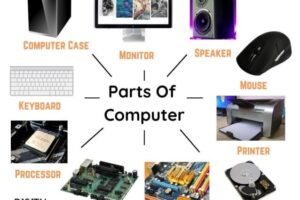
Basic of computer courses

What are the different types of computers courses ?
Overview of the parts, functions, and definition of a computer in Introduction to Computers. Operating Systems: Overview of widely used operating systems such as Linux, macOS, and Windows. Basic operating system navigation abilities, such as utilizing the desktop, managing files, and customizing settings. Typing Skills: Fundamental keyboarding abilities, such as touch typing methods and drills to enhance accuracy and speed. Word Processing: An overview of the programs used to create, edit, and format text documents (such as Microsoft Word and Google Docs). Typing, text formatting, picture insertion, and fundamental document layout are a few possible topics. Internet Basics: An overview of the internet that covers its functionality, frequently used terms, and web browsing techniques. Using computer browsers, browsing websites, conducting efficient web searches, and comprehending web addresses are a few possible topics.
Notepad
Taking Short Notes: Notepad offers a straightforward interface for quickly taking notes or making reminders. Editing Configuration Files: Because of its simplicity and convenience of use, it is frequently used to modify configuration files for many software applications. creating Code: Notepad is a popular tool among programmers for creating or altering code snippets, particularly for scripting languages such as HTML, CSS, JavaScript, and others. Creating HTML Pages: Basic web pages can be created by writing and editing HTML code in Notepad. Text File Viewing: It may also be used to view a variety of plain text files, such as README, log, and more. Making Scripts: Notepad can be used to write basic batch files or scripts that automate Windows system operations.
MS Paint
Microsoft Paint, also known as MS Paint, is a simple raster graphics editor that is pre-installed on Microsoft Windows computers. It has been a mainstay of the Windows OS for many years. Although MS Paint isn’t as feature-rich as other graphics editing programs like Adobe Photoshop or GIMP, it nevertheless works well for simple picture altering jobs because of its user-friendly interface. Typical applications for MS Paint include: creating basic sketches or pictures.
creating and manipulating simple photos, like rotating, cropping, and resizing. annotating or adding words to pictures. simple image editing, such adding color to certain areas or deleting portions of a picture. making straightforward charts or diagrams. modifying pictures or screenshots for presentations. doing basic digital artwork, or pixel art.
MS Word
Document Creation: Word is primarily used for creating documents of various types, including letters, reports, essays, resumes, and more. Formatting Text: Users can easily format text in Word documents, including changing fonts, styles, sizes, colors, and alignment. Inserting Images and Graphics: Word allows users to insert images, shapes, charts, and other graphical elements into their documents to enhance visual appeal and convey information effectively.
Spell Checking and Grammar Checking: Word includes built-in spell check and grammar check tools to help users ensure their documents are error-free. Page Layout and Design: Users can control the layout and design of their documents by adjusting margins, setting up headers and footers, adding page numbers, and creating columns.
Tables and Lists: Word enables users to create and customize tables and lists to organize and present information in a structured format. Collaboration: Word offers collaboration features, such as track changes and comments, which allow multiple users to review and edit documents simultaneously. Templates: Word provides a variety of pre-designed templates for different types of documents, saving users time and effort in creating professional-looking documents from scratch. Document Sharing: Word documents can be easily shared with others via email, cloud storage services, or collaboration platforms like Microsoft Teams. Integration with Other Microsoft Office Apps: Word seamlessly integrates with other Microsoft Office apps, such as Excel and PowerPoint, allowing users to incorporate data, charts, and slides from these applications into their Word documents.
MS Excel
Data Entry and Organization: Excel has a grid-like interface that makes it easy for users to efficiently enter, arrange, and manage vast volumes of data. formulae and Calculations: Excel has a large number of mathematical functions and formulae that users can use to work with data, automate operations, and conduct calculations. Data analysis: Sorting, filtering, and pivot tables are just a few of the effective tools available in Excel for data analysis. These tools let users summarize and visualize data in a variety of ways. Charts and Graphs: To graphically depict data and spot trends and patterns, Excel users can build a variety of charts and graphs, including pie charts, line graphs, and bar charts. Financial Management: Excel is frequently used for financial management operations, including forecasting, budgeting, tracking spending, and generating financial
MS Powerpoint
The creation of professional-looking presentations for corporate meetings, conferences, academic lectures, and other events is the main usage of PowerPoint. Slide Design: Using text, photos, shapes, charts, and multimedia components like audio and video clips, PowerPoint users may create visually engaging slides. Slide Transitions: To improve the presentation’s visual flow and audience engagement, PowerPoint provides a range of transition effects that can be used between slides. Animation: To create dynamic and interactive presentations, users can add animations to specific slide elements including text, photos, and shapes. Slide layouts: PowerPoint offers pre-made templates and slide layouts that users may alter to quickly and easily create presentations with a unified, polished appearance. Presenter Tools: Speaker notes, presenter view, and other presenter tools are included with PowerPoint.



